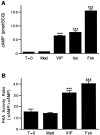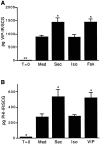Vasoactive intestinal peptide enhances its own expression in sympathetic neurons after injury
- PMID: 9651211
- PMCID: PMC6793472
- DOI: 10.1523/JNEUROSCI.18-14-05285.1998
Vasoactive intestinal peptide enhances its own expression in sympathetic neurons after injury
Abstract
Neurons in the adult rat superior cervical sympathetic ganglion (SCG) dramatically increase their content of vasoactive intestinal peptide (VIP) and its mRNA after axotomy in vivo and after explantation. Because the VIP gene contains a functional cAMP response element, the effects of cAMP-elevating agents on VIP expression were examined. VIP, forskolin, or isoproterenol increased cAMP accumulation in explanted ganglia. Secretin, a peptide chemically related to VIP, or forskolin increased VIP levels above those seen in ganglia cultured in control medium, whereas treatment with VIP or secretin increased the level of peptide histidine isoleucine (PHI), a peptide coded for by the same mRNA that encodes VIP. VIP or forskolin also increased VIP-PHI mRNA. In contrast, isoproterenol did not alter levels of VIP, PHI, or VIP-PHI mRNA. Although VIP or forskolin increased cAMP levels in both dissociated neurons and in non-neuronal cells, isoproterenol significantly stimulated cAMP accumulation only in the latter. VIP6-28 was an effective antagonist of the actions of exogenous VIP on cAMP and VIP-PHI mRNA in neuron-enriched cultures. When adult SCG explants were cultured in defined medium, endogenous VIP immunoreactivity was released. When VIP6-28 was added to such cultures, it significantly inhibited the increase in VIP-PHI mRNA that normally occurs. These data indicate that VIP, or a closely related molecule, produced by adult neurons after injury can enhance the expression of VIP. Such a mechanism may prolong the period during which VIP is elevated after axonal damage. The possibility is also discussed that, because VIP is present in preganglionic neurons in normal animals, its release during periods of increased sympathetic nerve activity could alter VIP expression in the SCG.
Figures








Similar articles
-
Galanin expression is decreased by cAMP-elevating agents in cultured sympathetic ganglia.Neuroreport. 1999 Apr 26;10(6):1221-4. doi: 10.1097/00001756-199904260-00012. Neuroreport. 1999. PMID: 10363928
-
Phenotypic plasticity in adult sympathetic ganglia in vivo: effects of deafferentation and axotomy on the expression of vasoactive intestinal peptide.J Neurosci. 1993 Apr;13(4):1642-53. doi: 10.1523/JNEUROSCI.13-04-01642.1993. J Neurosci. 1993. PMID: 8463841 Free PMC article.
-
Galanin and vasoactive intestinal peptide messenger RNAs increase following axotomy of adult sympathetic neurons.J Neurobiol. 1994 Feb;25(2):108-18. doi: 10.1002/neu.480250203. J Neurobiol. 1994. PMID: 7517435
-
VIP: molecular biology and neurobiological function.Mol Neurobiol. 1989 Winter;3(4):201-36. doi: 10.1007/BF02740606. Mol Neurobiol. 1989. PMID: 2698176 Review.
-
Expression of vasoactive intestinal peptide in lymphocytes: a possible endogenous role in the regulation of the immune system.Adv Neuroimmunol. 1996;6(1):29-36. doi: 10.1016/s0960-5428(96)00001-0. Adv Neuroimmunol. 1996. PMID: 8790779 Review.
Cited by
-
Pituitary adenylate cyclase-activating polypeptide and vasoactive intestinal peptide inhibit dendritic growth in cultured sympathetic neurons.J Neurosci. 2002 Aug 1;22(15):6560-9. doi: 10.1523/JNEUROSCI.22-15-06560.2002. J Neurosci. 2002. PMID: 12151535 Free PMC article.
-
A new concept in the pharmacology of neuroprotection.J Mol Neurosci. 2000 Feb-Apr;14(1-2):61-8. doi: 10.1385/JMN:14:1-2:061. J Mol Neurosci. 2000. PMID: 10854037 Review.
-
Vasoactive intestinal polypeptide requires parallel changes in adenylate cyclase and phospholipase C to entrain circadian rhythms to a predictable phase.J Neurophysiol. 2011 May;105(5):2289-96. doi: 10.1152/jn.00966.2010. Epub 2011 Mar 9. J Neurophysiol. 2011. PMID: 21389307 Free PMC article.
-
Neurotrophic regulation of calcium channels by the peptide neurotransmitter luteinizing hormone releasing hormone.J Neurosci. 2003 Aug 6;23(18):7169-75. doi: 10.1523/JNEUROSCI.23-18-07169.2003. J Neurosci. 2003. PMID: 12904477 Free PMC article.
-
Intrahypothalamic pituitary adenylate cyclase-activating polypeptide regulates energy balance via site-specific actions on feeding and metabolism.Am J Physiol Endocrinol Metab. 2013 Dec;305(12):E1452-63. doi: 10.1152/ajpendo.00293.2013. Epub 2013 Oct 22. Am J Physiol Endocrinol Metab. 2013. PMID: 24148346 Free PMC article.
References
-
- Aloisi F, Rosa S, Test U, Bonsi P, Russo G, Peschle C, Levi G. Regulation of leukemia inhibitory factor synthesis in cultured human astrocytes. J Immunol. 1994;152:5022–5031. - PubMed
-
- Ariano MA, Briggs CA, McAfee DA. Cellular localization of cyclic nucleotide changes in rat superior cervical ganglion. Cell Mol Neurobiol. 1982;2:143–156.
-
- Audigier S, Barberis C, Jard S. Vasoactive intestinal polypeptide increases inositol phospholipid breakdown in the rat superior cervical ganglion. Brain Res. 1986;376:363–367. - PubMed
-
- Baldwin C, Sasek CA, Zigmond RE. Evidence that some preganglionic sympathetic neurons in the rat contain vasoactive intestinal peptide- or peptide histidine isoleucine amide-like immunoreactivities. Neuroscience. 1991;40:175–184. - PubMed
Publication types
MeSH terms
Substances
Grants and funding
LinkOut - more resources
Full Text Sources
